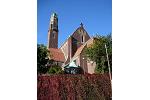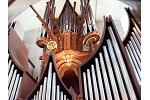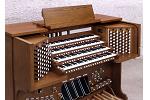ALLEN ORGAN INSTALLATIONS
Englebrekt Church, Stockholm, Sweden
Four-Manual, 138 stop control, 92 digital stop Allen Organ
The Engelbrekt church was dedicated in 1914. It was designed by professor Lars Israel Wahlman who merged the architectural styles of the Scandinavian stylistic expression with the then contemporary, "Jugend" style. The structure became a Scandinavian landmark representing the spirit of the arts and crafts architectural movement.
Two of the most remarkable features of the Engelbrekt church are the ornately elaborate speaking pipe façade and the unusually large organ loft, which has room for several large choirs and an orchestra - up to 120 musicians! The loft has been fully utilized every Good Friday, since 1923, when Bach's St. Matthew Passion is performed. The nave, seating 1400 people, is generally filled to capacity during the annual service.
A Brief History of the Engelbrekt Organs:
Circa 1914
Engelbrekt's first instrument was built by Swedish organ builders E A Setterquist & Son of Örebro. It had a specification typical
of its time, with 40 speaking stops, 3 manuals and pedal. The action was mechanical/pneumatic and the console was in
front of the prospect (pipe façade).
Circa 1929
After only 12 years the parish agreed that a larger instrument would be more appropriate in the vast space of this huge
church and a contract was signed with P.L Åkerman & Lund organ builders. The new organ was going to be more than twice
as large as the first. With 95 stops it included a Choir organ, "Fernwerk" (situated in the tower) and a high-pressure division.
The organ had electro pneumatic action - the technology preferred at the time - and was inaugurated in 1929 with specifications
typical of the Swedish romantic era.
1955
Well into the next decades, the "Organ movement" was slowly building in Europe. Its goal was
to reclaim the ideals of the baroque era. And so, the Englebrekt organ underwent constant
alterations between 1929 and 1955. In the end it reached the staggering sum of 101 stops
claiming its place as the second largest church organ in Sweden.
1964
In 1964, Engelbrekt church built a new organ desiring to further accomplish all the goals of the
Organ movement. It was inaugurated at the church's 50-year jubilee and was comprised of 86
stops over 7 divisions, played from 5 manuals and pedal. The completely mechanical action
(both playing and registration) made it unique in Northern Europe.
Decades passed until it was recently determined that a new choir organ was needed. Integrating a new instrument in the existing architectural environment proved to be a challenge. The delicate "whole-concept" of the central point of the church was not to be disturbed. Additionally, the structure was guarded by the antiquarian authorities.
2011
To install a really useful, versatile and well sounding-organ, the parish decided the best solution would be a totally "invisible"
instrument. Therefore, a larger pipe-organ would be ruled out, making a digital instrument the only solution.
Stefan Therstam, Organist, Engelbrekt church and Professor, Royal College of Music, Stockholm said, "Knowing the capabilities
of the Allen Organ Company's instruments for nearly a quarter of a century, and through the knowledge and expertise
of Allen's representative, I had no hesitation when recommending that the parish should choose a
custom built Allen organ to fill our needs. Now, after some months of use we feel we have really made the right decision." He
continued, "Being one of the most important church music venues of Sweden's capital Stockholm, the Engelbrekt parish has,
in this Allen Organ, acquired a whole new palette of musical opportunities".
Click here to see images of this historic church's interior.
For a stunning 360 degree tour of the interior and exterior of Englebrekt church visit: http://www.360cities.net/image/engelbrekt-church#-178.33,-13.09,25.8
Click below to watch Bossi's Cantate Domino performed at Englebrekt Church. Organist: Stefan Terstam
http://youtu.be/gaw8oFeCKTM


